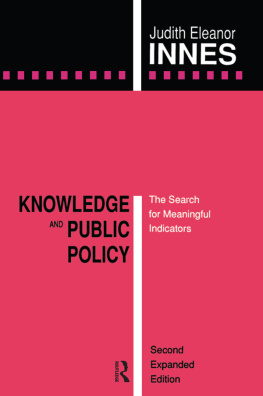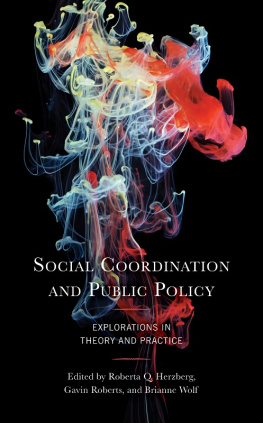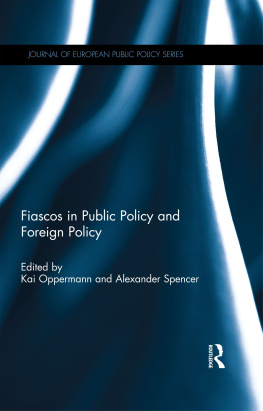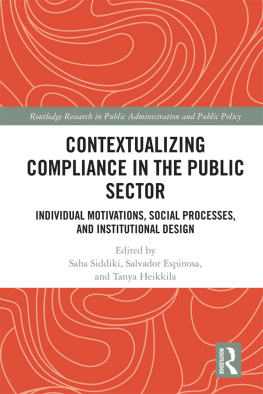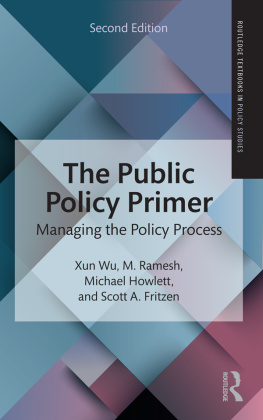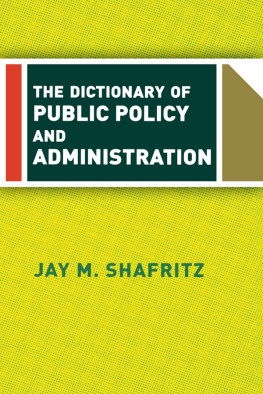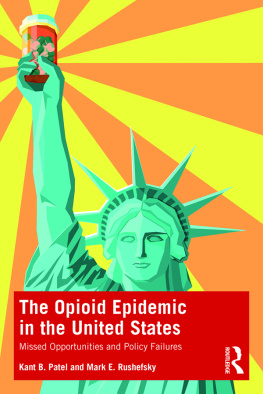Originally published in 1975 by Elsevier Scientific Publishing Company as Social Indicators and Public Policy: Interactive Processes of Design, by Judith Innes De Neufville.
First published 1990 by Transaction Publishers
Published 2019 by Routledge
2 Park Square, Milton Park, Abingdon, Oxon OX14 4RN
52 Vanderbilt Avenue, New York, NY 10017
Routledge is an imprint of the Taylor & Francis Group, an informa business
New material this edition copyright 1990 by Taylor & Francis.
All rights reserved. No part of this book may be reprinted or reproduced or utilised in any form or by any electronic, mechanical, or other means, now known or hereafter invented, including photocopying and recording, or in any information storage or retrieval system, without permission in writing from the publishers.
Notice:
Product or corporate names may be trademarks or registered trademarks, and are used only for identification and explanation without intent to infringe.
Library of Congress Catalog Number: 89-5189
Library of Congress Cataloging-in-Publication Data
Innes, Judith.
Knowledge and public policy : the search for meaningful indicators by
Judith Eleanor Innes.2nd expanded ed.
p. cm
Rev. ed. of: Social indicators and public policy. 1975.
Includes bibliographical references.
ISBN 0-88738-810-8
1. Social indicators. 2. Public policy. 3. Knowledge, Sociology of. I.
Innes, Judith. Social indicators and public policy. II. Title.
HN25.156 1989
306.42dc20
89-5189
CIP
ISBN 13: 978-0-88738-810-1 (pbk)
To Eleanor, Judy, Karen, Kathy, and Chriswhose advise and support have made a real difference.
If we dont get the data, the decision will just be based on politics.A local elected official in California on the subject of whether the county should enact controls on growth.
KNOWLEDGE IN PUBLIC POLICY
When it really comes down to it, there is not much that can be said with confidence about how knowledge influences policy. As a society we must be pretty confident it does have an influence, or we would not keep producing studies and statistics directed to policy. Policy makers and the public, like the official quoted above, widely subscribe to a view that policy making should be well informedif not, then it will be merely political. Certainly major public decisions are often surrounded by facts and analyses. But it turns out to be difficult to pinpoint the effects of such information. Why do they persuade or not persuade? What do they communicate? How do they fit into the processes through which public actions are devised and implemented? And if these formal kinds of information are not influential, what is?
This book is about how one particular kind of informationsocial indicatorscan come to be important to public decisions. It is grounded in case histories of the development and use of three widely discussed indicators: the measures of unemployment, living standards, and crime. The purpose was to explore what indicators and decision processes would have to be like for the indicators to play a significant role in deliberate policy choices. The research concludes that, under certain conditions, indicators can be pivotal to policy debates or integral to administrative decision making. Indicators that are influential in resolving policy controversy, according to this research, are theoretically sound and meshed with publicly understood concepts. They are developed and overseen by people representing a variety of interests and knowledge. A process is carefully constructed to require public exposure of the indicators and policy attention to them. The indicators themselves are institutionalized and protected from tampering. To achieve all this takes effective institutional design, communication, and negotiation as well as time, energy, and a major public commitment to addressing a policy problem.
The research I did for this book has been useful as much to show how formal information such as indicators can be tied explicitly into policy as to show that there often are real, practical limits to achieving this direct linkage. For me, the research has been particularly important for the questions it raised even more than for those it answered, and for the intellectual journey it initiated. I have come, fifteen years later, to formulate a different view of how and why knowledge is linked to public action than that which framed my investigation of social indicators. This new model of the alliance of knowledge and policy in no way invalidates the findings of this book. Rather, it provides a better way of understanding much of what was going on.
This introductory essay to the second edition will explore basic features of this alternative perspective. It will draw both on intellectual developments in the growing literature on knowledge in society and on my own historical and field research since this book was published. The essay will illuminate certain aspects of the cases in this book, but it will also provide a more realistic and, I believe, more useful way of understanding how knowledge and public action shape one another. With such a framework we also have a more realistic basis for prescribing ethical and effective ways to inform public choice.
LINKING KNOWLEDGE AND POLICY
The view of knowledge and its links to policy which framed my study of social indicators was one that was widely shared in the social sciences in the late 1960s. It is a view grounded in the positivist conception of knowledge and knowledge use. I will refer to it here as the scientific model of knowledge use, though it represents an oversimplified and somewhat mechanistic conception of science. In this form it has become an implicit working model that frames the expectations of the average participant or observer about the role of information in policy. Though experts and those deeply involved may know the reality to be more complex, no one has thus far offered an equivalent alternative view. The scientific model remains, if only by default, the principal way in which we understand and prescribe for the use of knowledge in policy.
The key normative and descriptive elements of this model are several. First, the view assumes that policy makers should use formal information, such as statistics or the findings of social science, to aid their decisions in a way analogous to how a scientist tests a hypothesis and is persuaded by the evidence of carefully designed experiments. For this view of knowledge use to apply, policy makers must represent unitary interests and be able to make meaningful, deliberate choices. Their task is to choose options that are likely to achieve goals on the basis of criteria, evidence, and logic. When their actions do not appear to be influenced by the evidenceas is often the case in practicethis view would attribute to the policy makers laziness, duplicity, or undue responsiveness to pressures of special interests.
What counts as knowledge use in the scientific model is explicit information processing, supportive of identifiable decisions. What counts as knowledge includes facts, statistics, theories, and findings of formal research and analysis. Experts who are unbiased and outside of a political process produce such knowledge. Knowledge production and use are, and should be, separate activities. The process of informing policy is therefore stepwise, with a division of labor where policy makers do the goal setting, experts do the analysis, and policy makers make decisions.

